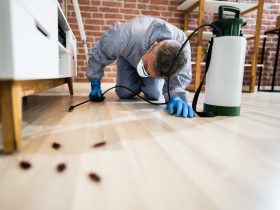When pests invade your home, the first instinct for many people is to head to the nearest store and grab whatever spray or trap is on the shelf. DIY pest control can feel like a quick, affordable fix—but is it truly effective in the long run? More importantly, does it solve the root of the problem?
While there are cases where DIY solutions may help, the truth is that many pest problems are more complex than they appear. Understanding the differences between DIY methods and professional pest control treatments can help you make the best decision for your home, health, and wallet.
Here’s a detailed look at the pros and cons of each approach—and why professional treatment is often the most effective option.
The Appeal of DIY Pest Control
For many homeowners, the idea of solving a pest problem themselves is attractive for a few reasons:
- Convenience: Products are readily available at hardware or grocery stores.
- Cost: DIY treatments often appear cheaper up front.
- Control: You can apply products immediately without waiting for an appointment.
There are also countless tutorials online for homemade traps, natural sprays, and repellents, all promising quick results.
But here’s the catch: DIY pest control may only treat the symptoms, not the source.
The Limitations of DIY Solutions
While some minor pest problems can be managed temporarily with over-the-counter sprays or traps, most infestations are more deeply rooted. The limitations of DIY pest control include:
1. Short-Term Results
Store-bought products often provide immediate, surface-level relief. You might kill the ants you see in your kitchen, but if the colony is nesting in your wall or under the foundation, they’ll be back within days.
2. Misidentification of the Pest
Different pests require different treatment strategies. Misidentifying the species—whether it’s termites vs. carpenter ants, or mice vs. rats—can lead to ineffective treatment. Professionals are trained to accurately identify pests and choose the right solutions.
3. Incorrect Application
Pesticides and baits must be used properly to be safe and effective. Misuse can lead to health risks for your family or pets—and in some cases, make the pest problem worse by scattering the infestation or encouraging resistance.
4. No Access to Professional-Grade Products
Many of the most effective pest control treatments aren’t available to the public. Professionals have access to stronger, regulated products designed to eliminate pests at the source, not just the surface.
5. No Long-Term Prevention
DIY methods rarely include steps to prevent future infestations. Without sealing entry points, addressing food sources, or identifying breeding areas, the problem often returns.
Why Professional Pest Control Works
Hiring a licensed pest control service means getting more than just a spray treatment. You’re getting a comprehensive approach to pest management, including:
1. Thorough Inspection
Professionals don’t guess. They inspect your home or business carefully, identifying the pest, locating the source, and evaluating the extent of the problem.
2. Customized Treatment Plans
A one-size-fits-all approach doesn’t work with pests. Professional services tailor their treatments based on the type of pest, the severity of the issue, and the layout of your property.
3. Safe and Targeted Solutions
Technicians are trained to apply treatments safely and strategically, minimizing risk to your family, pets, and the environment while maximizing effectiveness against pests.
4. Integrated Pest Management (IPM)
IPM is a long-term strategy that combines monitoring, prevention, and control. It’s not just about getting rid of pests today—it’s about keeping them away for good.
5. Follow-Up and Monitoring
Professional services don’t stop after the first visit. Many offer ongoing monitoring and retreatments if needed, ensuring pests don’t return.
When DIY Might Be Enough
That said, DIY isn’t always the wrong choice. For very minor issues—like a few ants near a window, a lone spider in the garage, or a fruit fly outbreak in the kitchen—simple store-bought solutions or homemade traps may be enough.
But if you see any of the following, it’s time to call a professional:
- Frequent or recurring pest sightings
- Droppings or urine stains
- Strange smells or sounds in the walls
- Signs of structural damage (chewed wires, sawdust, tunnels in wood)
- Pests appearing during the day (especially roaches or rodents)
These signs typically indicate a deeper, more widespread problem.
Final Thoughts
DIY pest control can be helpful for small, isolated problems—but it’s rarely a permanent solution. For real infestations, hidden colonies, or recurring issues, professional pest control is not just more effective—it’s safer, faster, and more cost-efficient over time.
The peace of mind that comes with knowing your home is fully protected is worth the investment. A professional knows what to look for, how to treat it, and how to prevent it from coming back.
If you’re unsure whether your pest issue is something you can handle yourself or if it’s time to bring in the experts, don’t hesitate to reach out to a licensed pest control service for an inspection. It’s the first step to taking your home back—and keeping it pest-free for good. We recommend Swift Pest.







